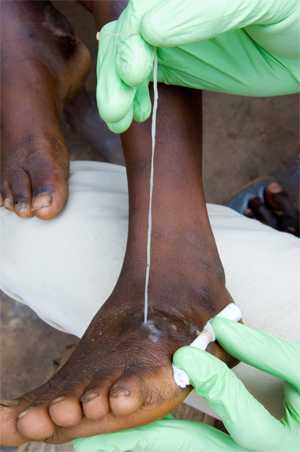The Burden of Guinea Worm Disease (GWD, Dracunculiasis)
Since the beginning of the Guinea Worm Eradication Program (GWEP), the number of cases of GWD has decreased from an estimated 3.5 million cases in 20 countries in 1986 to 22 cases 2015 (in Chad, Ethiopia, Mali, and South Sudan).

This image shows an aid worker removing an emerging Guinea worm by wrapping the worm around a piece of gauze to apply traction. Credit: The Carter Center
Guinea worm disease (GWD) is a preventable infectious disease that affects poor communities in remote parts of Africa that lack safe drinking water. The infection is spread to people who drink water containing copepods (tiny "water fleas" too small to be clearly seen without a magnifying glass) that have swallowed Guinea worm larvae. When a person drinks this contaminated water, the copepods are digested, releasing the Guinea worm larvae into the human body. These larvae mature, mate, and about 10-14 months later, the pregnant female worm, now measuring up to 1 meter in length, creates a painful burning blister on the skin, often on the lower leg. To soothe the pain, a person infected with GWD may soak the blister in cool water. While the blister is in the water, the female worm comes out of the skin and deposits hundreds of thousands of larvae into the water. These larvae are then swallowed by the copepods, and the cycle starts over again.
GWD can be prevented by simple interventions, most of which involve making water safer to drink. Successful interventions include case containment, cloth and pipe filters for drinking water, and ABATE® application, an insecticide that can be applied to contaminated drinking water sources, such as small ponds or open wells.
More on: Guinea Worm
- Page last reviewed: February 24, 2016
- Page last updated: March 8, 2016
- Content source:


 ShareCompartir
ShareCompartir